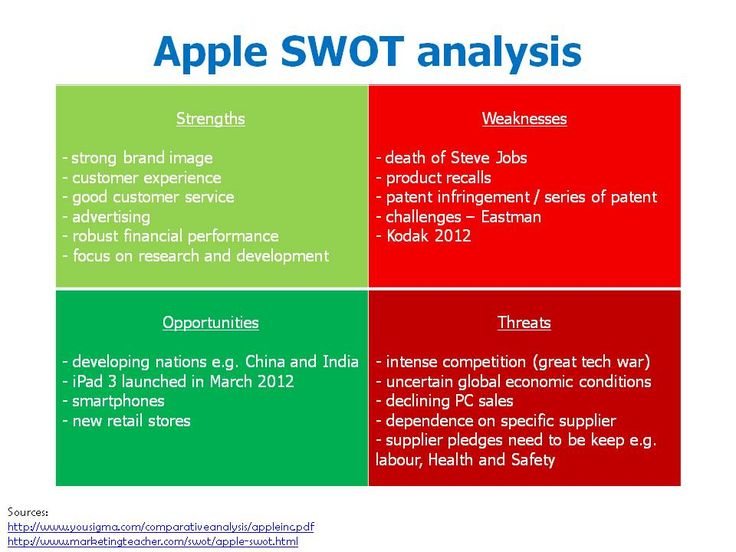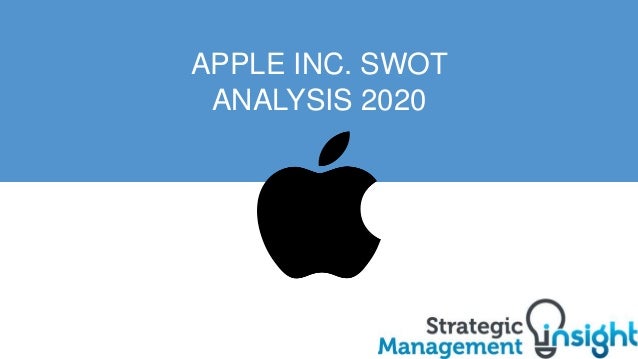Therefore, this Apple SWOT analysis, SWOT analysis of Apple, or SWOT analysis Apple assists in presenting the strategic factors that result in business growth. Having diverse operations in various markets around the globe, Apple deals with a different set of SWOT analysis Apple factors, which are based on regional situations as well. SWOT analysis: Apple Inc. Apple headquarters, Cupertino, California Apple's founder Opportunity External, positive factors that creates positive potential for an organization Weakness Internal, negative factors that puts you at a competitive disadvantage demand for products like.
Company Background
| Name | Apple Inc. |
|---|---|
| Founded | April 1, 1976 |
| Logo | |
| Industries served | Computer hardware (iMac, iMac Pro, MacBook, MacBook Pro, MacBook Air) Software (iOS, iPadOS, MacOS, watchOS, tvOS, Safari, iWork, iMovie) Consumer electronics (iPhone, iPad, Apple TV, Apple Watch, AirPods, HomePod, Beats) Internet Services (iCloud, Apple Pay, App Store, Mac App Store, TV App Store, Book Store, Apple Music) |
| Geographic areas served | Worldwide - 509 retail stores in 25 countries (271 stores in the U.S. 238 stores in other 24 countries) and online stores in over 100 countries[2] |
| Headquarters | Cupertino, California, United States |
| Current CEO | Tim Cook |
| Revenue (US$) | 260.174 billion (2019) 2% decrease over 265.595 billion (2018) |
| Profit (US$) | 55.256 billion (2019) 7.2% decrease over 59.531 billion (2018) |
| Employees | 137,000 (2019) |
| Main Competitors | Samsung Electronics Co., Ltd., Google Inc., Amazon.com, Inc., Huawei Technologies Co., Ltd. International Business Machines Corporation, Cisco Systems, Inc., Microsoft Corporation, Dell Inc., LG Electronics, Lenovo Group Limited, Sony Corporation and many other computer hardware, computer software, consumer electronics and internet companies. |
Business description
Apple Inc., established in 1977, is the largest technology company by revenue and one of the most valuable companies, both in terms of market capitalization and brand value, in the world.[3] The company has revolutionized the smartphone market and has created one of the most iconic brands in history.
Apple has built its business by selling and manufacturing computer hardware and software, but experienced significant growth and success by entering consumer electronics market with iPod, iPad and iPhone products.
The company designs, manufactures and markets smartphones, tablets, personal computers, wearables and accessories, and offers many related services including financial services.
The main company’s product is iPhone, which runs on Apple’s iOS operating system and accounts for 54.7% of the total company’s revenue.[1] In 2019, the company introduced three new iPhones: iPhone 11, iPhone 11 Pro and iPhone 11 Pro Max. Mac products are the second largest company’s product category by revenue, generating 9.9% of the total company’s revenue.[1] Mac products include MacBook Air, Mac mini and Mac Pro and run macOS operating system. iPad category, which includes iPad, iPad Pro, iPad Air and iPad mini products, accounts for 8.2% of the total Apple’s revenue. The rest of the company’s products include wearables, home and accessories, which account for another 9.4% of the revenue and is the fastest growing Apple’s product category, growing by 41% in 2019.
In addition to the consumer electronics and computer hardware products, Apple is offering many services to its customers, including:
- Digital Content Stores. The company operates digital content stores that allow customers to discover and download applications and digital content, including music, videos, books, games and podcasts.
- Subscription based services. Apple’s services like Apple Music and Apple TV+.
- AppleCare services. AppleCare is a fee-based service that provides additional coverage of phone hardware repairs, accidental damage and even theft.
- Other services. These services include iCloud, licensing, Apple Card, Apple Pay and Apple News+.

Services generated 17.8% of the company’s revenue and was the second fastest growing category for Apple, growing 16% in 2019.[1]
Apple operates and sells its products in over 100 countries, but the U.S. China, the U.K. Canada and Australia are the most important markets. In 2019, the company’s net sales through its direct (sales in company’s 508 stores in 25 countries and sale through online stores) and indirect distribution (sales made by third-party sellers) channels accounted for 31% and 69%, respectively.[1]
Apple competes in a highly competitive industry and has to continuously perform at its best to be able to stay ahead of its competition. Apple competes primarily on price, product and service features, quality and reliability, design innovation, a strong third-party software and accessories ecosystem. There are many large and well-positioned rivals in the industry, so a fierce competition requires constant innovation and taking advantage of the arising opportunities.
Apple Inc. SWOT Factors
Strengths
1. Unique ability to design and develop proprietary hardware, software, applications and services
Apple Inc.’s ability to design and develop its own hardware, software, applications and services allows the company to introduce unique, innovative and easy-to-use products and solutions for its customers.
Unique, innovative and easy-to-use products and services that integrate seamlessly into one Apple ecosystem are the reasons why customers buy Apple’s premium products and enjoy using them. In other words, it creates a competitive advantage no other company can match.
Figure 1. Apple’s product ecosystem
Source: Strategic Management Insight
Apple’s product ecosystem is comprised of:
- Hardware products. Products including iPhone, Mac computers, iPad, AirPods, Apple TV, Apple Watch and other computer hardware as well as consumer electronics.
- Software. Apple provides operation systems for every product category it sells. The main operation systems that go with Apple products are iOS, macOS, iPadOS, watchOS and tvOS.
- Application software. Includes applications such as iLife, iWork, iMovie, Safari, Final Cut Pro, Apple Books and other applications which enable users to use Apple products for work or entertainment.
- Services. The company offers many service to its users, including: App Store, Apple Music, Apple News+, Apple TV+, Apple Arcade, Apple Card, Apple Pay, iCloud, AppleCare, licensing and many other services.
Apple’s ecosystem is the result of the company’s ability to design a wide variety of integrated proprietary hardware, software, applications and services.

Many of Apple’s competitors have tried and still try to imitate the success of Apple’s product ecosystem, but fail due to not having strong capabilities in designing, manufacturing and developing both hardware and software, applications and services.
Samsung Electronics, Apple’s strongest competitor, lacks a comprehensive OS and has very few apps and services to offer for its customers. Google, Apple’s second largest competitor is very good at software, application software and services, but has only developed a few unsuccessful hardware products.
Except for Google and Samsung Electronics, few other companies could seriously attempt to challenge Apple’s competitive advantage.
2. Powerful brand supported by strong advertising and marketing capabilities
Apple’s brand is the world’s most valuable and recognizable brand. According to Interbrand[4] and Forbes[5], the Apple brand is worth US$234.241 billion and US$205.5 billion, respectively. Brand value is closely related to its recognition, meaning that Apple is also one of the world’s most recognizable brands. Their brand recognition is supported by its vast product ecosystem.
Moreover, Apple has a reputation of developing highly innovative, well designed, and well-functioning products, as well as for delivering a great customer experience and sound financial performance.
The company has been able to achieve such strong brand recognition and reputation through its advertising and marketing capabilities. For over 30 years, Apple has been significantly relying on an external advertising agency TBWA/Chiat/Day help for launching its marketing and advertising campaigns.[6] These campaigns resulted in two very well-known advertisements – ‘1984’ and ‘Think Different’ and helped Apple to create an iconic brand image. Recently, the company has focused its efforts to strengthening its own in-house advertising and marketing teams by attracting a lot of new talented people to the internal agency.[6] This should result in lower costs and ever stronger marketing and advertising capabilities.
Apple’s excellence in creating spectacular marketing campaigns, its superior advertising capabilities, premium quality products and ability to deliver an excellent customer experience has allowed the company to build the most powerful brand in the world.
3. One of the most loyal customer base in every major product market where the company operates
Apple enjoys a very loyal customer base, considering that it doesn’t even have a loyalty program. Customers praise the company’s products for their innovation, design, ease-of-use, reliability and the status they convey. This is why they continue to buy and use Apple’s products even when there are better or cheaper options available in the market.
Apple’s retention rates in the smartphone market are the highest among its major rivals. According to BankMyCell, Apple retains 74.6% of its customers, compared to Samsung’s retention rate of 63.9% and LG’s 40.7%.[7]
Figure 2. Retention Rates in The Smartphone industry

Source: BankMyCell[7]
Swot Analysis Case Study Of Apple Inc
Apple also enjoys the most loyal customer base in the tablet market, where the company was able to grow its market share significantly even when the market declined slightly.
Brand Keys, a consultancy agency, issues a “Customer Loyalty Engagement Index” study each year. It examines the world’s top brands in many industries and how loyal customers are to these brands. According to their latest study,[8] Apple’s brand enjoys the most loyal customer base in the tablet market. The company held this position for over 5 years. From 2014 to 2017, Apple also had the most loyal customer base in the smartphone and laptop markets as revealed by the same customer loyalty engagement study each year.[9][10][11][12] Although the company has lost the top loyalty position in these markets, it still has some of the most loyal customers in every market it operates.
Figure 3. Brand Keys’ Customer Loyalty Engagement Index (Apple’s market leader positions 2014-2017)
Swot Analysis Of Apple Inc Pdf
Source: Brand Keys [9][10][11][12]
Customer loyalty is a key to every technology company’s success. Apple’s ability to retain its customers and do it so well brings it a competitive advantage no rival can match.
